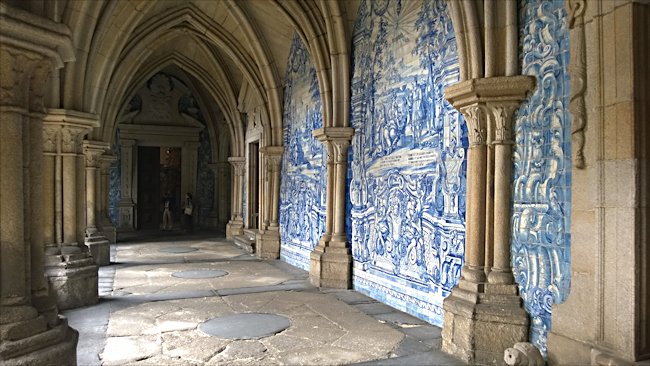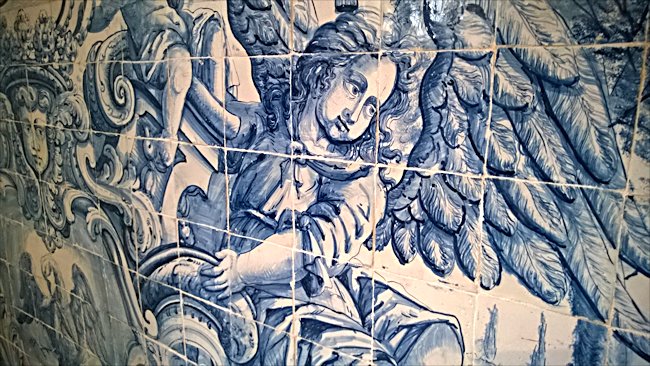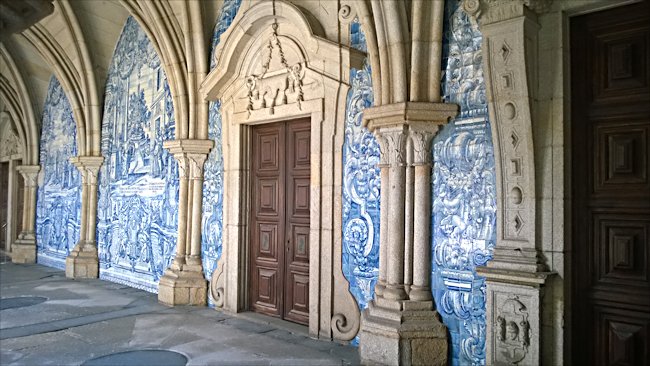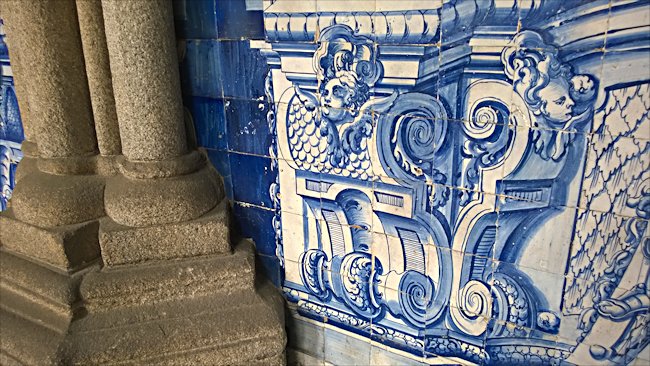Porto Cathedral's Gothic Cloisters
The cloister walls of Porto's Cathedral are decorated with blue and white pictorial tiles some of which depict scenes from "The Metamorphosis" (Ovidius) and the life of Mother Mary. They are dramatic and grab your attention. You will find some of these tiles on the outside of the cathedral walls. This style of internal and external wall decoration can be seen around the world, wherever the old Portuguese Empire had an influence. What is the history of the Portuguese liking from blue and white "Azulejos" tiles?

Porto's Cathedral cloisterd decorated with blue and white tiles
After the fall of the Roman Empire the Iberian Peninsula was invaded by "Barbarian" tribes. Portugal, as a country, did not exist. There were many conflicts between the different tribes but eventually the Visigoths unified Spain and Portugal as one country under one King. Local civil wars continued to break out between different war lords.
During one of these conflicts a Berber army landed in Gibraltar on 30 April 711 A.D. These fierce North African warriors came mainly from Morocco and the foothills of the Atlas Mountains. They had recently converted to Islam after it was introduced to this part of Africa by Arab traders
The Berber army originally came to help one of the warring Visigoth factions but decided to conquer the whole country. After a seven-year bloody campaign they were victorious occupying modern day Portugal, Spain, Andorra, Gibraltar plus central and southern France. They brought with them their architects, builders and craftsmen. Their Christian opponents called them Moors; a term that was used to refer to Muslims.

A winged angel in the cloisters of Porto's cathedral
All around Porto you will see tiles used to decorate the outside of buildings. This was a skill brought to Portugal by the Moorish craftsmen. This unique way of painting ceramic tiles is called "Zellige", which in Arabic meant polished stone. Complex geometric forms were used to make pretty recurring patterns. Under Islamic law, depiction of living beings was not allowed. These tiles were hand drawn and painted.
When the Christian kings and their armies eventually forced out the Moors from southern Europe, many of the craftsmen stayed behind. They adapted their craft to appeal to their new Christian masters, customers and benefactors. Images were now painted on tiles.
Potters from Northern Europe and Italy introduced new styles of tile decoration in the 16th century when they established workshops first in Spain and later in Portugal. These blue-and-white polychrome tiles now depicted scenes from the Bible, lives of the saints, allegorical and mythological scenes. They are known as "Azulejos" tiles.

The Cathedral Cloisters are decorated with blue and white tiles that were orignally a Moorish idea.
Later hunting and landscape scenes became fashionable along with images of the nobility and hard-working peasants. As well as a decorative function they protected the outside of the buildings. We used to educate the masses on how to live their life and the Scriptures. The look very attractive but there was also a serious reason for the continued use of putting tiles on the outside and inside walls of buildings. One of the main reasons for their use is protection from the elements and a longterm cost benefit. Buildings with tiled walls do not have to be painted every other year. If they do get dirty all they need is a wash and rubdown with a cloth to maintain their good as new look. They also stay cool to touch even on sunny days.
What is a cloister?
Many monasteries, cathedrals, convents and colleges have a covered walkway around a central square. The walkways were normally colonnaded and open to the square on one side. This allowed the monks, priests, nuns and students to take exercise by walking around the square whilst being protected from the rain or sun. It enabled them to read or discuss teachings whilst keeping the body fit as well as the mind. It also provided a way of getting one part building to the next without the need of an umbrella.
Many monasteries, cathedrals, convents and colleges have a covered walkway around a central square. The walkways were normally colonnaded and open to the square on one side. This allowed the monks, priests, nuns and students to take exercise by walking around the square whilst being protected from the rain or sun. It enabled them to read or discuss teachings whilst keeping the body fit as well as the mind. It also provided a way of getting one part building to the next without the need of an umbrella.

The gothic style stonework contrasts with the fussy ornate painted stonework on the tiles.
The interior of many mediaeval cathedrals were dark even on a sunny day. Cloisters were very bright in comparison and an ideal place for monks to write manuscripts and create copies of the Bible. This section of the cloister would be known as a Scriptorium. Cloisters also functioned as schoolrooms, places of study. Some cloisters had small wooden rooms constructed that faced onto the courtyard. Monks would be allowed to sit on their own, in peace, to study the Bible. On the opposite wall from the little rooms there was normally a bookcase to store instructional religious books. In more northern climes shutters were used the colonnades to keep out the worst of the wind and rain. Some were glazed.
Travel Books


Tweet